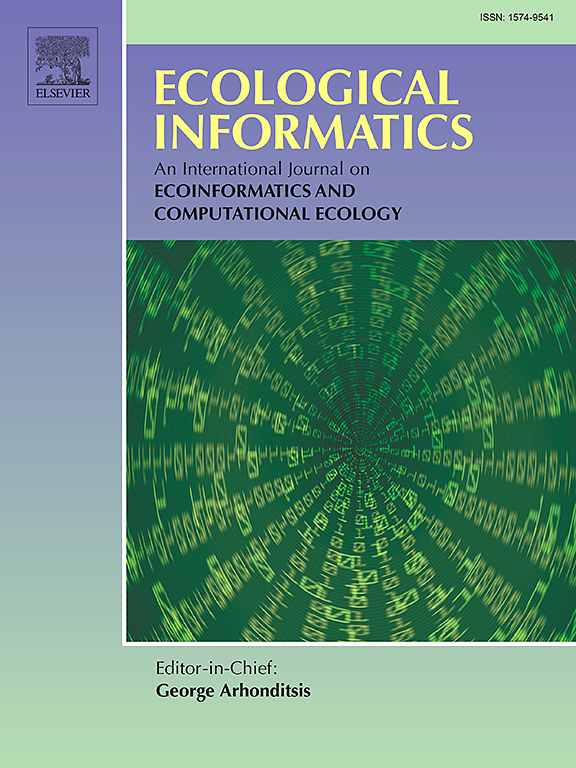Hyperspectral characterization of vegetation in hemiboreal, boreal and Arctic peatlands using a geographically extensive field dataset
IF 5.8
2区 环境科学与生态学
Q1 ECOLOGY
引用次数: 0
Abstract
Northern peatlands store up to 25% of global soil organic carbon and function as important hotspots for biodiversity. However, they are facing degradation from climate change driven by human activities as well as anthropogenic land use changes, up to the point of endangering the ecosystems' functioning and the storage of soil organic carbon entailed within them. The surface vegetation of northern peatlands is an important indicator of the ecosystem's functioning and ecohydrology, highlighting the importance of its large-scale, continuous monitoring. Approaches utilizing hyperspectral data for monitoring vegetation health and species composition can also be applied to peatland vegetation. To support the development of methods for interpreting hyperspectral satellite data from peatlands, we conducted a comprehensive in situ study of hemiboreal, boreal, sub-Arctic and Arctic peatland vegetation. We measured the reflectance spectra (350–2500 nm), soil moisture, and various vegetation-related attributes from a total of 446 vegetation plots in Estonia and Finland, from a 1500 km south-north interval. We then investigated (i) the spectral variation in surface vegetation of hemiboreal, boreal, sub-Arctic and Arctic peatlands and (ii) explored its connection to plant functional types (PFTs) and soil moisture, as well as evaluated the potential of hyperspectral data in estimating PFT cover using simple vegetation indices and partial least square (PLS) regression. Our results indicate that (i) the best spectral regions to retrieve information regarding the PFT vary greatly especially between vascular plants and bryophytes, (ii) the reflectance at an individual wavelength as well as simple vegetational index can, to some extent, predict the PFT, and that (iii) the PLS regression can predict the PFT with good accuracy. Overall, our findings demonstrate the potential of using hyperspectral data in monitoring PFTs in northern peatlands. The spectral library and the ancillary data from the peatland sites collected for this study are available as open data.利用地理范围广泛的野外数据集,对半干旱、寒带和北极泥炭地的植被进行高光谱特征描述
北方泥炭地储存了全球土壤有机碳的 25%,是重要的生物多样性热点地区。然而,由于人类活动导致的气候变化以及人为的土地利用变化,泥炭地正面临着退化,甚至危及生态系统的功能及其所储存的土壤有机碳。北方泥炭地的地表植被是生态系统功能和生态水文的重要指标,这就凸显了对其进行大规模、持续监测的重要性。利用高光谱数据监测植被健康和物种组成的方法也可应用于泥炭地植被。为了支持泥炭地高光谱卫星数据解读方法的开发,我们对半寒带、寒带、亚北极和北极泥炭地植被进行了全面的实地研究。我们测量了爱沙尼亚和芬兰南北相距 1500 公里的 446 个植被地块的反射光谱(350-2500 纳米)、土壤湿度和各种植被相关属性。然后,我们研究了(i)半寒带、寒带、亚北极和北极泥炭地表层植被的光谱变化,(ii)探讨了其与植物功能类型(PFTs)和土壤湿度的联系,并评估了高光谱数据在使用简单植被指数和偏最小二乘法(PLS)回归估算植物功能类型覆盖率方面的潜力。我们的研究结果表明:(i) 检索 PFT 信息的最佳光谱区域差异很大,尤其是维管束植物和块根植物之间;(ii) 单个波长的反射率和简单植被指数在一定程度上可以预测 PFT;(iii) PLS 回归可以准确预测 PFT。总之,我们的研究结果证明了利用高光谱数据监测北方泥炭地 PFT 的潜力。为本研究收集的泥炭地光谱库和辅助数据以开放数据形式提供。
本文章由计算机程序翻译,如有差异,请以英文原文为准。
求助全文
约1分钟内获得全文
求助全文
来源期刊

Ecological Informatics
环境科学-生态学
CiteScore
8.30
自引率
11.80%
发文量
346
审稿时长
46 days
期刊介绍:
The journal Ecological Informatics is devoted to the publication of high quality, peer-reviewed articles on all aspects of computational ecology, data science and biogeography. The scope of the journal takes into account the data-intensive nature of ecology, the growing capacity of information technology to access, harness and leverage complex data as well as the critical need for informing sustainable management in view of global environmental and climate change.
The nature of the journal is interdisciplinary at the crossover between ecology and informatics. It focuses on novel concepts and techniques for image- and genome-based monitoring and interpretation, sensor- and multimedia-based data acquisition, internet-based data archiving and sharing, data assimilation, modelling and prediction of ecological data.
 求助内容:
求助内容: 应助结果提醒方式:
应助结果提醒方式:


